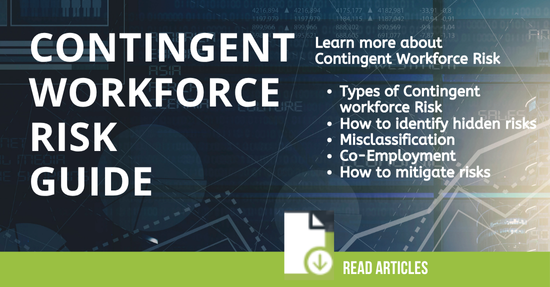Managing a contingent workforce brings flexibility, but it also introduces legal risks - especially Co-Employment Risk. In this article, we look at what Co-Employment is, why it is a risk for employers and how to mitigate it.
What is Co-Employment?
Co-employment occurs when two or more companies share control over a worker and are jointly considered employers for legal and tax purposes. In contingent labor programs, this often happens when:
-
A staffing agency supplies a worker, but the client company directs their day-to-day tasks.
-
An independent contractor is treated like a full-time employee - with fixed hours, specific workflows, or integration into daily operations.
If these boundaries blur, courts, the IRS, or the Department of Labor may determine that co-employment exists, exposing your business to liability.
Why Co-Employment is a legal risk for Employers
The consequences of mismanaging co-employment can be serious. If you’re not careful, co-employment can lead to expensive lawsuits, government audits, back taxes, and reputational damage.
-
Liability for Benefits: If co-employment is determined, the company may be responsible for providing benefits such as health insurance, paid time off, or retirement plans.
-
Tax Penalties: Misclassifying a worker as a contractor when they’re effectively functioning as an employee could lead to back taxes, interest, and penalties.
-
Wage Claims: Co-employed workers may bring claims for unpaid overtime, minimum wage violations, or improper termination.
-
Harassment and Discrimination Liability: Co-employment status means your company could be held liable for workplace violations - even if the worker was placed by an agency.
-
Wrongful Termination or Immigration Issues: If your company exerts too much control over hiring, firing, or day-to-day supervision, it may become entangled in legal disputes over terminations or immigration violations.
How a VMS Helps Avoid Co-Employment Risk
A Vendor Management System (VMS) like Conexis provides the compliance framework you need to minimize co-employment exposure. Here’s how:
Assignment Duration Monitoring
One of the simplest red flags for co-employment is how long a worker stays on assignment. Conexis enables the automated monitoring of tenure policies, tracks assignment start and end dates, flags overextensions, and prompts HR or procurement to reevaluate long-term needs. By managing tenure proactively, companies avoid creating the perception that temps are being treated like permanent employees.
Independent Contractor Compliance and Verification
Conexis supports IC vetting by integrating classification tools and workflows to verify that an IC meets legal criteria (based on IRS or Department of Labor tests). It can house documents proving IC status, such as business licenses, contracts, and insurance, and flag any missing or expired items.
Worker Classification and Audit Trails
All contingent worker engagements should be fully documented. Conexis maintains an audit trail of contracts, classification justification & decisions, work scopes, and vendor responsibilities, providing legal protection in the event of a claim.
Workforce Compliance Monitoring
Conexis automates compliance checks for background screenings, credential verification, onboarding documents, and contract deliverables. Whether you need to confirm that a contractor is legally allowed to work or that a healthcare temp has up-to-date certifications, your VMS ensures nothing slips through the cracks.
Non-Compliance Notifications
Automated alerts are your early warning system. Whether it’s a contract expiring, a missing insurance certificate, or an IC working outside their defined scope, Conexis flags these risks in real time—giving you the chance to fix issues before they escalate into legal liabilities.
Protect Your Business from Co-Employment Risk
In today’s flexible labor market, co-employment risk is a reality - but it doesn’t have to be a liability. Conexis VMS delivers the tools to manage compliance, reduce risk, and protect your business.
Download the Free VMS Buyer’s Guide
Take a 2-Minute Self-Guided Product Tour
Book a Free Consultation with a Workforce Compliance Expert
Discover the Power of Conexis VMS
Conexis VMS is purpose-built for organizations seeking to manage their contingent labor spend effectively. Here’s why we're the right choice:
- Fast Deployment: Get up and running in weeks, not months
- Transparent Pricing: Flexible pricing with no hidden costs
- White-Label Ready: Customize the platform with your brand
- Real-Time Insights: Make faster decisions with built-in analytics
- Audit-Ready Compliance: Store contracts, worker data, and rates in one secure hub
About Conexis VMS
Conexis is an award-winning Vendor Management System built for organizations that want the power of enterprise software without the complexity or cost.
Leveraging the latest technology, Conexis delivers the expertise, reliability and security of enterprise systems, while offering the flexibility, user friendliness and tailored, personal service you require. Learn more about our Company and why organizations Choose Conexis VMS.
Looking to Switch Your VMS or Just Getting Started?
Whether you are looking to Switch your VMS, or just Getting Started, we are here to help. Contact Us for a Free No-Obligation Consultation, See how Easy Conexis is to use by taking a quick 2 minute Self-Guided Online Demo, or Book a Personal Demo Today!
Additional articles on the Managing Contingent Workforce Risk: Managing Risk Guide
- Co-Employment Risk: How a VMS Shields you from Risk
- Misclassification: A Critical Risk for Contingent Workforce Programs
- 10 Ways a VMS helps reduce Contingent Workforce Compliance
- How to Identify the Hidden Risks in Your Contingent Workforce Program
- How to Track Contingent Workforce Compliance Risk with a VMS
- What is Contingent Workforce Compliance Risk?
- Is your Staffing Agency putting your company at risk?
- The Benefits and Risks of Hiring Contingent Workers
- The Top 5 Contingent Workforce Risks and How to Manage them
- How a VMS keeps you compliant and audit-ready






